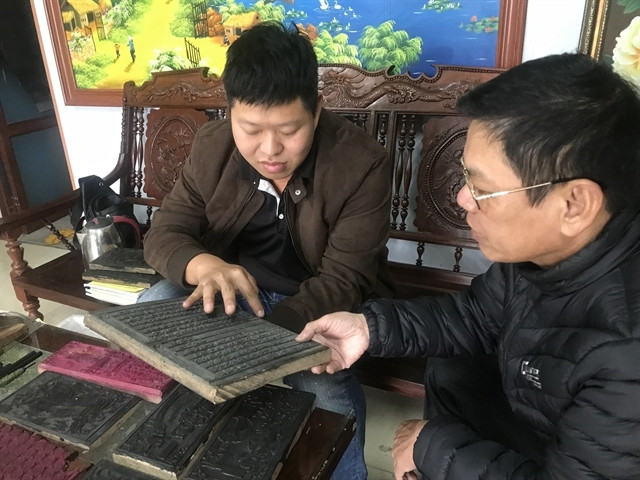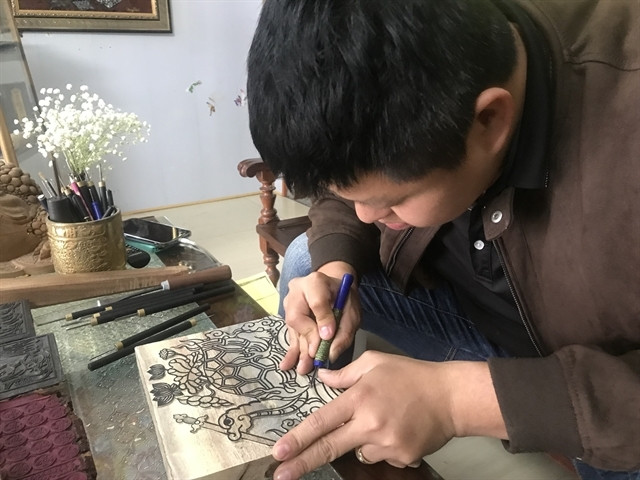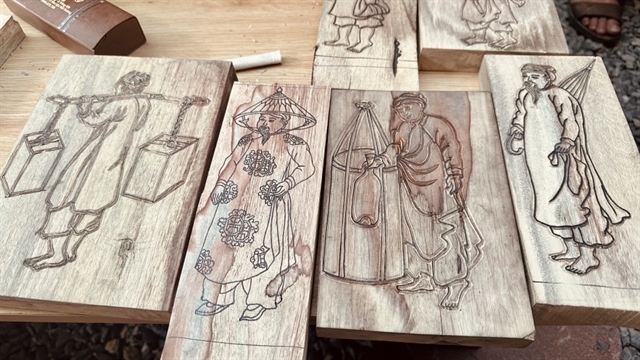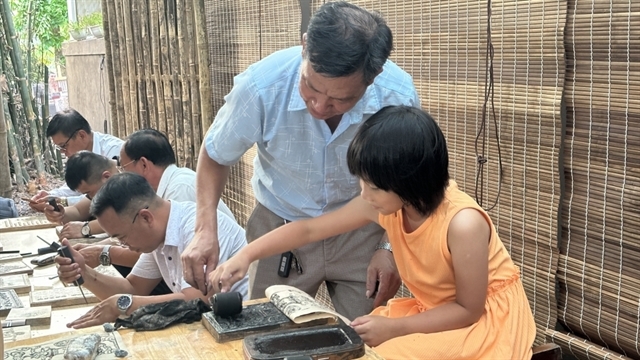 |
| RESTORED: The woodblocks carved with Buddhist scriptures has been preserved by local artisans for hundreds of years. - VNA/VNS Photo Tiến Vĩnh |
As the home of woodblock printing from the 15th to the 19th centuries, Thanh Liễu Village in the northern province of Hải Dương has preserved thousands of sets of printing woodblocks and seals.
However, the art of woodblock printing has declined over time, and now there are only a few households able to maintain this ancient craft.
A project aiming to revive the technique has recently been launched by local artisans in collaboration with the Centre for Research, Development, and Application of Vietnamese Craft Village Products, running until the end of June.
The project "Thanh Liễu Woodblock Prints - The Journey to Revive a Craft Village", includes a series of activities such as the workshop on woodblock carving and printing techniques.
Participants have the opportunity to directly experience the process of creating, cutting and printing with woodblocks -- from selecting the wood, preparing a block, carving it, inking and then printing with it -- all under the instruction of local master artisans.
Heritage
 |
| METICULOUS: Nguyễn Công Đạt, a native of Thanh Liễu Village, carves a wooden block depicting the legend of 'The Turtle Returning the Magical Sword'. VNA/VNS Photo Tiến Vĩnh |
According to a history book on Hải Dương, the forefather of the craft was Lương Như Hộc, born in 1420, in Hồng Lục Village of Trường Tân District (now Tân Hưng Ward). He was the third laureate in Court feudal examination.
Following two diplomatic missions to China, Hộc learned woodblock printing there, and brought the craft home and taught residents in Thanh Liễu, Liễu Tràng, and Khuê Liễu villages.
Documents about Vietnamese craft villages reveal that Hộc’s first two apprentices were Phạm Niên and Phạm Đới. They helped spread woodblock printing in the locale.
The three villages formed the national centre of woodblock printing, during which strong men carved woodblocks, while women did printing and children trimmed paper.
The craft brought about relatively affluent lives to residents in the villages at that time.
Local artisans say the craft requires great care in every step, from selecting wood to carving, preparing ink, rolling it onto the woodblocks, and printing on poonah paper to ensure the print quality.
It takes a craftsman from three to five days to complete a carving. However, some take several months, depending on the length of the text, and the theme requested.
 |
| FIT TO PRINT: Some classic Thanh Liễu wooden carvings. Photo tuoitrethudo.vn |
To become a woodblock printer, a trainee must undergo a three-year apprenticeship. They must be proficient in Han Chinese and Vietnamese ideographic Nôm scripts, understand writing rules, and recognise reversed characters because the woodblock carving is done in reverse. Woodblock printing is largely inherited through family lineage and traditional practices.
To carve scriptures, one must be deeply skilled. By the end of the Nguyễn Dynasty (1802-1945), in Liễu Tràng and Thanh Liễu villages, there were hundreds of woodblock carvers, but only about 20 were proficient to do the work.
Over hundreds of years, Thanh Liễu Village cut and printed again and again thousands of sets of scriptures, books and seals, including the printing woodblocks of the Nguyễn Dynasty recognised by UNESCO as the first World Documentary Heritage in Việt Nam in 2009.
Later, the villagers ventured out to make a living and introduced the craft to other regions across the country. Many printing workshops in Hà Nội’s old streets of Hàng Trống and Hàng Gai were run by people from the three villages.
Like so many traditional crafts, woodblock printing in Thanh Liễu is at risk of fading away, as only a few households remain in the profession.
Preservation
“It is not easy to preserve the craft skills of our ancestors in this rapidly developing era,” says artisan Phạm Sơn Lương.
“The older artisans have done their utmost to bring back the quintessence of this craft. But without the creativity and passion of the younger artisans to actively preserve and promote it, well, it might end up disappearing. It's a dying art."
One such effort is the "Thanh Liễu Woodblock Prints - The Journey to Revive a Craft Village" project.
Young artisan Nguyễn Công Đạt says the initiative is aimed at preserving national heritage, while also creating opportunities for the development of the local craft villages.
"We hope that the woodblock printing craft will continue to thrive and be more widely embraced by the public in the future,” he tells Tuổi Trẻ Thủ Đô newspaper.
 |
| FUTURE CRAFTER: Visitors to the Woodblock Carving and Printing Techniques workshop try the process. Photo tuoitrethudo.vn |
Events within the project have attracted many people, particularly the young, and even foreigners who are interested in the craft and its legacy.
Nguyễn Hoàng Lan, a final-year student at the University of Industrial Fine Arts, says she was excited to be able to directly see the master woodblock carvers and participate in the process.
“Woodblock printing is not only beautiful, but also contains precious cultural and historical values. I hope I can learn more and contribute to spreading this art form to more people, not only in Việt Nam but also outside the country,” she says. VNS